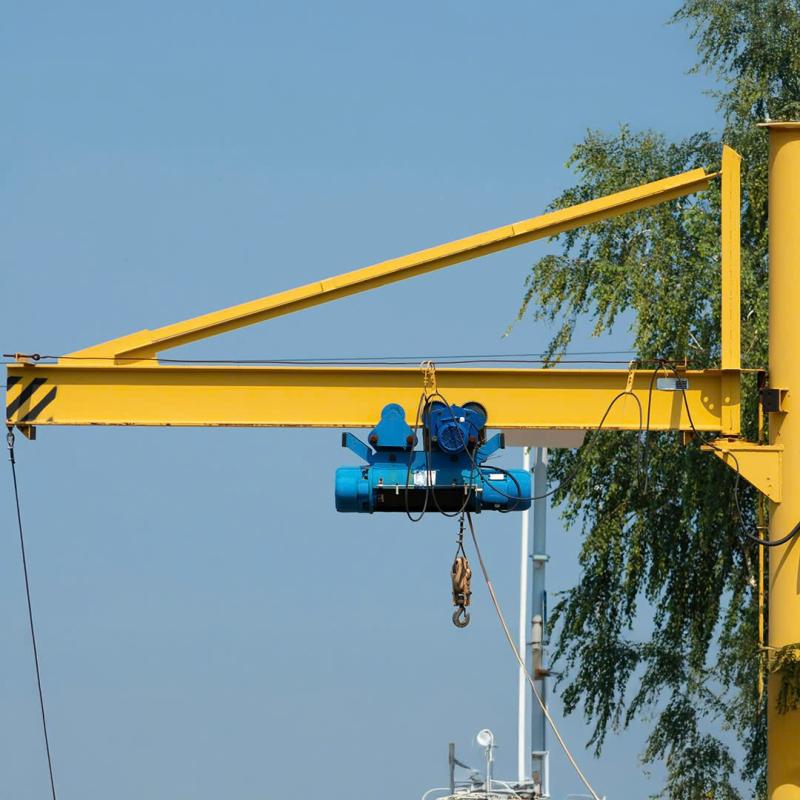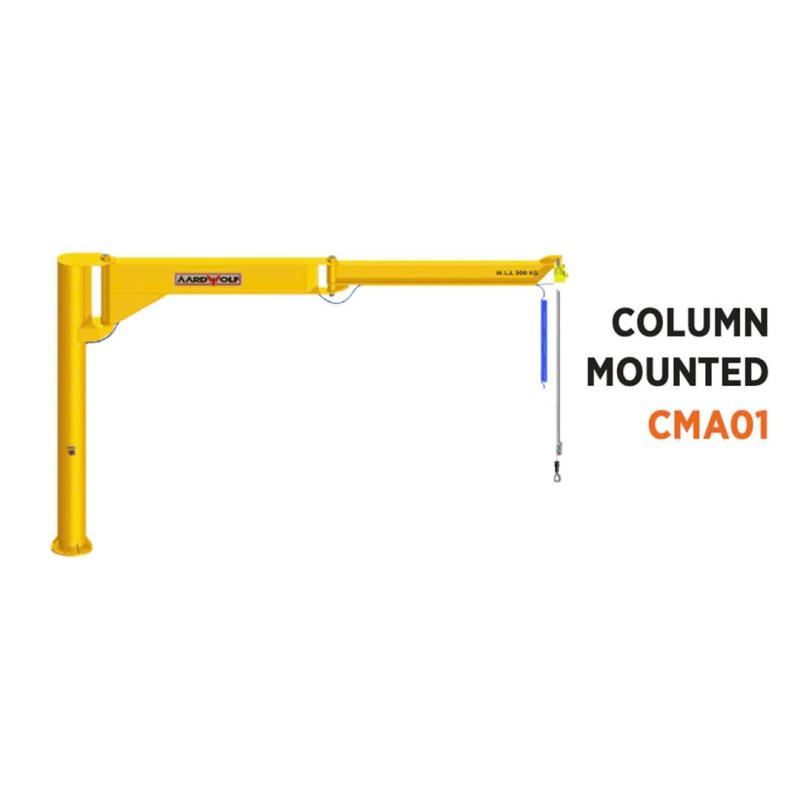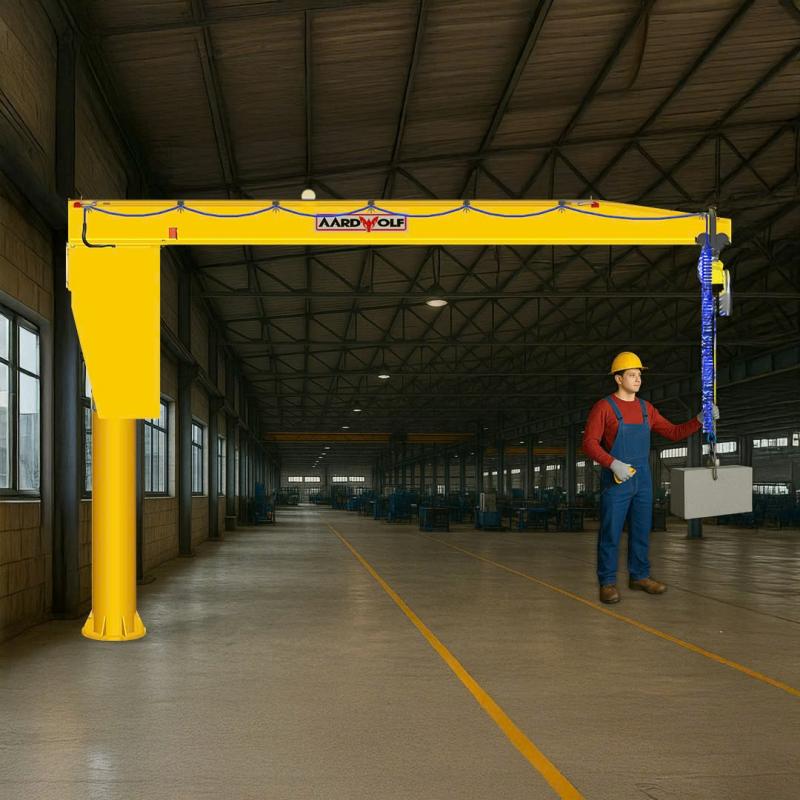



Jib Cranes stand out as one of the most versatile and cost-effective material handling tools, particularly for facilities needing localized lifting with minimal installation overhead.
This article explores the core types of jib cranes—freestanding, wall mounted, ceiling mounted, articulating, and pillar jib cranes—and analyzes the specific cost benefits each type offers across different applications and industries.

Jib cranes are lifting devices with a horizontal arm (jib or boom) that supports a moveable hoist. Unlike overhead or gantry cranes, jib cranes are compact, simple to install, and cost-efficient in both small and large-scale environments.
Learn how to choose the ideal jib cranes for different applications, especially when balancing budget and lifting capacity.
The freestanding jib crane is the most robust and flexible option, capable of full 360° rotation. It is anchored to a reinforced concrete foundation and doesn’t rely on building structures for support.
Cost Benefits:
Long-term ROI due to high durability
Independent of facility structure (no need for wall or roof reinforcement)
Ideal for outdoor or open-space applications where layout changes frequently
A wall mounted jib crane attaches directly to a structural wall or column, offering 180° to 200° of swing coverage. It’s best suited for workstations close to walls or support beams.
Cost Benefits:
No floor space required
Lower upfront cost due to no foundation needed
Great for retrofitting into existing spaces
Explore different types of jib cranes and their use cases to understand which model fits your layout.
This type of jib crane is mounted to the ceiling or overhead support beam, maximizing floor space. It operates over the work area and offers significant coverage.
Cost Benefits:
Eliminates floor obstruction
No additional column or base structure needed
Perfect for narrow spaces or congested shop floors
The articulating jib crane features a two-arm system with separate pivots, allowing operators to maneuver around obstacles and into tight work zones.
Cost Benefits:
Reduces need for manual repositioning
Efficient handling of irregular workstations
Increases worker safety by minimizing awkward lifting angles
Also known as a column-mounted jib crane, the pillar jib is bolted directly to the floor and offers consistent support for repetitive lifting tasks.
Cost Benefits:
Strong structural integrity for heavy-duty operations
Long service life with low maintenance
Ideal for assembly lines or permanent work zones
Compare smart jib cranes featuring intelligent safety to evaluate how these models reduce operational hazards and labor costs.
The installation process can significantly impact the total cost of ownership. A simple setup might save on initial expenses, but long-term performance and flexibility are equally crucial.
Explore the diverse ranges of jib cranes to see which installation method works best for your facility and budget.



Jib cranes have fewer moving parts than gantry or overhead systems. This translates to:
Lower frequency of repairs
Reduced maintenance contracts
Less operational downtime
Unlike large-scale systems, jib cranes provide a straightforward lifting solution that serves a dedicated area. This focused efficiency eliminates unnecessary lifting movements and reduces energy consumption.
From light-duty workstations to heavy-duty fabrication areas, there's a jib crane suited to every task. See the potential of lifting solutions in specialized industries like metal fabrication, automotive assembly, and warehouse management.
Today’s smart jib cranes come equipped with advanced technologies that automate lifting tasks and integrate with facility management systems.
Programmable lifting sequences reduce operator workload
Sensor-based diagnostics predict maintenance needs
Remote control access improves safety and operational flexibility
Learn how smart jib cranes solutions are shaping the future of intelligent manufacturing.
Articulating and pillar jib cranes improve accuracy in positioning parts like doors, engines, and subassemblies—saving time and reducing human error.
Wall and ceiling mounted jib cranes help streamline packing, sorting, and loading without consuming critical floor space.
Freestanding and column-mounted cranes provide steady support for steel, stone, or wood panels, maximizing productivity and reducing labor fatigue.
For in-depth analysis, see Selecting the Right Crane for Your Application.
When it comes to optimizing material handling systems, Jib Cranes offer unmatched cost efficiency, space utilization, and functional flexibility. From reducing installation costs and energy usage to lowering maintenance and improving safety, every type of jib crane offers unique financial and operational advantages.

Whether you're considering a freestanding, wall mounted, ceiling mounted, articulating, or pillar jib crane, make sure your choice aligns with your workflow demands and long-term goals.
Explore more about Exploring Different Types of Smart Jib Cranes to make the smartest investment for your lifting needs.
1. How to operate a Jib Crane safely
3. Over brace jib crane wall mounted
5. Is a Jib Crane a Gantry Crane
6. Articulated Jib Crane Wall Mounted
8. Manual Counterbalance Crane
10. Over Braced Jib Crane Column Mounted
11. Powered counterbalance Crane
Sign up to receive the latest info on new Aardwolf products, special offers and more.
By signing up you agree to receive emails from Aardwolf with news, special offers, promotions and other information. You can unsubscribe at any time.